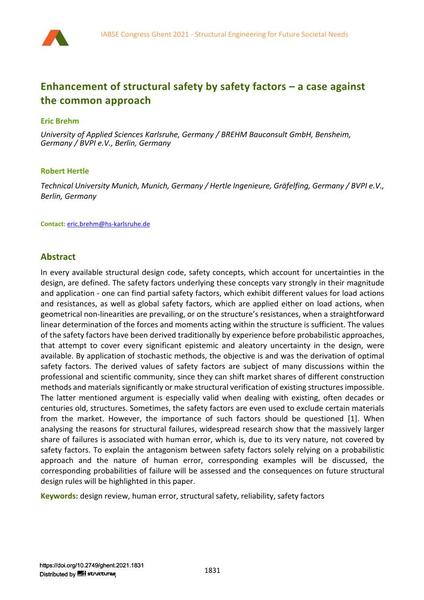Enhancement of structural safety by safety factors – a case against the common approach

|
|
|||||||||||
Bibliographic Details
| Author(s): |
Eric Brehm
(University of Applied Sciences Karlsruhe, Germany / BREHM Bauconsult GmbH, Bensheim, Germany / BVPI e.V., Berlin, Germany)
Robert Hertle (Technical University Munich, Munich, Germany / Hertle Ingenieure, Gräfelfing, Germany / BVPI e.V., Berlin, Germany) |
||||
|---|---|---|---|---|---|
| Medium: | conference paper | ||||
| Language(s): | English | ||||
| Conference: | IABSE Congress: Structural Engineering for Future Societal Needs, Ghent, Belgium, 22-24 September 2021 | ||||
| Published in: | IABSE Congress Ghent 2021 | ||||
|
|||||
| Page(s): | 1831-1838 | ||||
| Total no. of pages: | 8 | ||||
| DOI: | 10.2749/ghent.2021.1831 | ||||
| Abstract: |
In every available structural design code, safety concepts, which account for uncertainties in the design, are defined. The safety factors underlying these concepts vary strongly in their magnitude and application - one can find partial safety factors, which exhibit different values for load actions and resistances, as well as global safety factors, which are applied either on load actions, when geometrical non-linearities are prevailing, or on the structure’s resistances, when a straightforward linear determination of the forces and moments acting within the structure is sufficient. The values of the safety factors have been derived traditionally by experience before probabilistic approaches, that attempt to cover every significant epistemic and aleatory uncertainty in the design, were available. By application of stochastic methods, the objective is and was the derivation of optimal safety factors. The derived values of safety factors are subject of many discussions within the professional and scientific community, since they can shift market shares of different construction methods and materials significantly or make structural verification of existing structures impossible. The latter mentioned argument is especially valid when dealing with existing, often decades or centuries old, structures. Sometimes, the safety factors are even used to exclude certain materials from the market. However, the importance of such factors should be questioned [1]. When analysing the reasons for structural failures, widespread research show that the massively larger share of failures is associated with human error, which is, due to its very nature, not covered by safety factors. To explain the antagonism between safety factors solely relying on a probabilistic approach and the nature of human error, corresponding examples will be discussed, the corresponding probabilities of failure will be assessed and the consequences on future structural design rules will be highlighted in this paper. |
||||
| Keywords: |
reliability structural safety human error design review Safety Factors
|
||||
| Copyright: | © 2021 International Association for Bridge and Structural Engineering (IABSE) | ||||
| License: | This creative work is copyrighted material and may not be used without explicit approval by the author and/or copyright owner. |
||||
